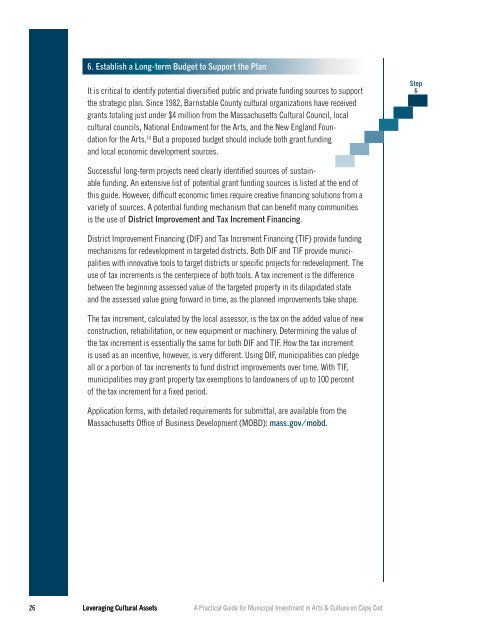Leveraging Cultural Assets for Economic Development - Cape Cod ...
Leveraging Cultural Assets for Economic Development - Cape Cod ...
Leveraging Cultural Assets for Economic Development - Cape Cod ...
- No tags were found...
You also want an ePaper? Increase the reach of your titles
YUMPU automatically turns print PDFs into web optimized ePapers that Google loves.
6. Establish a Long-term Budget to Support the PlanIt is critical to identify potential diversified public and private funding sources to supportthe strategic plan. Since 1982, Barnstable County cultural organizations have receivedgrants totaling just under $4 million from the Massachusetts <strong>Cultural</strong> Council, localcultural councils, National Endowment <strong>for</strong> the Arts, and the New England Foundation<strong>for</strong> the Arts. 14 But a proposed budget should include both grant fundingand local economic development sources.Step6Successful long-term projects need clearly identified sources of sustainablefunding. An extensive list of potential grant funding sources is listed at the end ofthis guide. However, difficult economic times require creative financing solutions from avariety of sources. A potential funding mechanism that can benefit many communitiesis the use of District Improvement and Tax Increment Financing.District Improvement Financing (DIF) and Tax Increment Financing (TIF) provide fundingmechanisms <strong>for</strong> redevelopment in targeted districts. Both DIF and TIF provide municipalitieswith innovative tools to target districts or specific projects <strong>for</strong> redevelopment. Theuse of tax increments is the centerpiece of both tools. A tax increment is the differencebetween the beginning assessed value of the targeted property in its dilapidated stateand the assessed value going <strong>for</strong>ward in time, as the planned improvements take shape.The tax increment, calculated by the local assessor, is the tax on the added value of newconstruction, rehabilitation, or new equipment or machinery. Determining the value ofthe tax increment is essentially the same <strong>for</strong> both DIF and TIF. How the tax incrementis used as an incentive, however, is very different. Using DIF, municipalities can pledgeall or a portion of tax increments to fund district improvements over time. With TIF,municipalities may grant property tax exemptions to landowners of up to 100 percentof the tax increment <strong>for</strong> a fixed period.Application <strong>for</strong>ms, with detailed requirements <strong>for</strong> submittal, are available from theMassachusetts Office of Business <strong>Development</strong> (MOBD): mass.gov/mobd.26<strong>Leveraging</strong> <strong>Cultural</strong> <strong>Assets</strong> A Practical Guide <strong>for</strong> Municipal Investment in Arts & Culture on <strong>Cape</strong> <strong>Cod</strong>
















